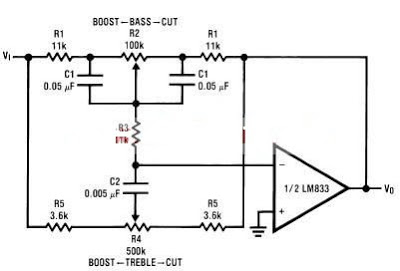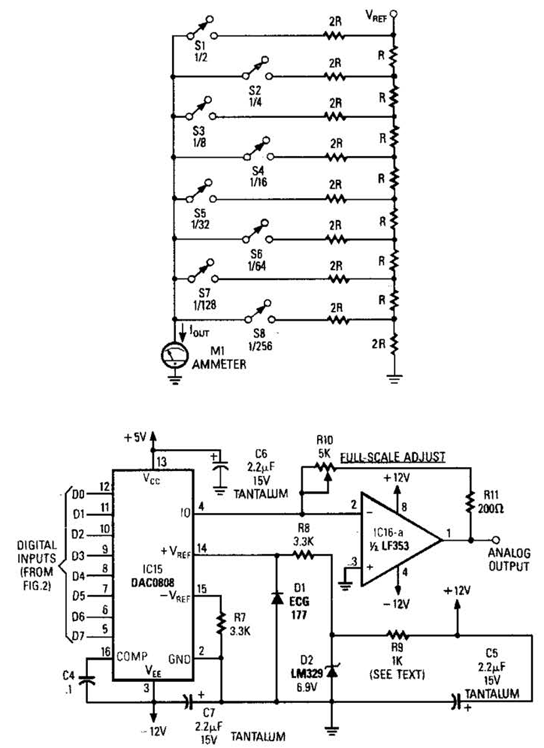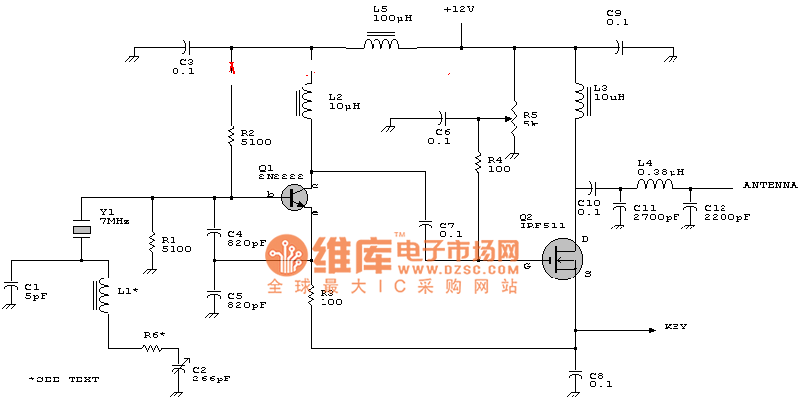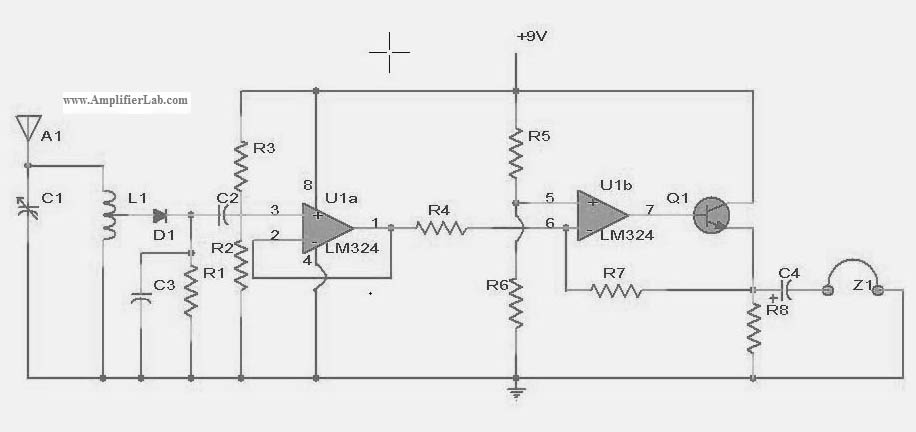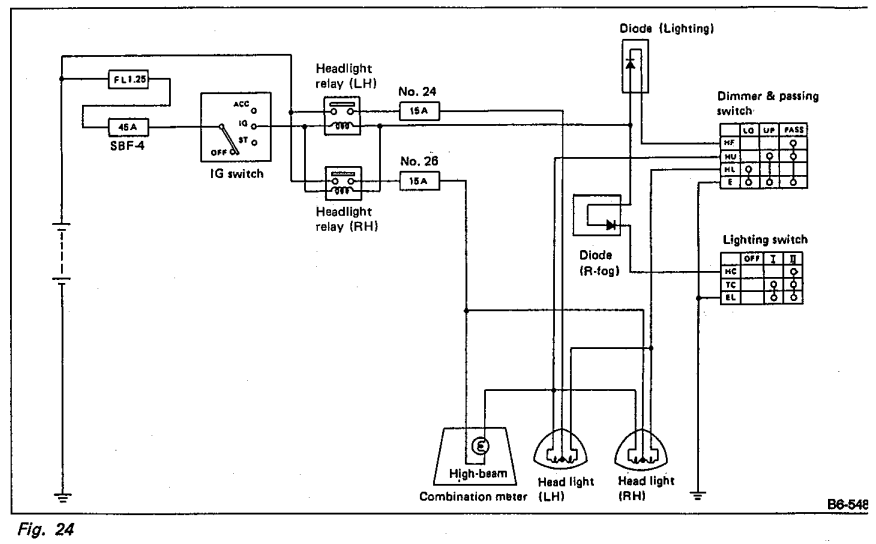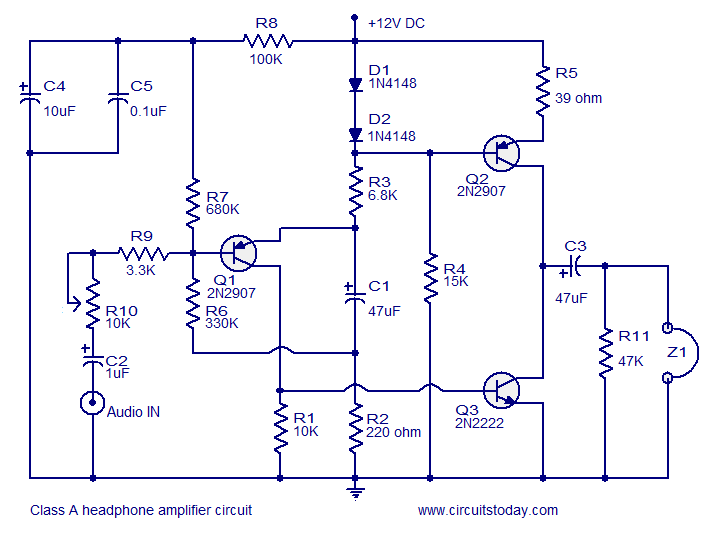
555 Fm Circuit Circuit
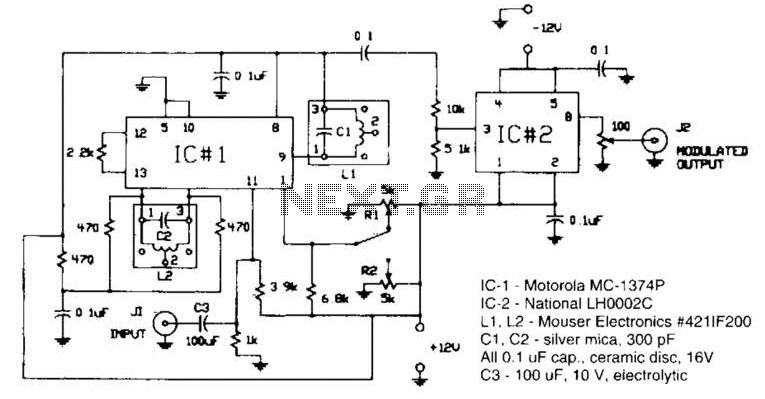
Circuit for applying a DC-coupled FM or PPM to a 555 configured as an oscillator. IC-1 is a Motorola MC-1374P, and IC-2 is a National LH0002C. L1 and L2 are Mouser Electronics #421IF200. C1 and C2 are silver mica capacitors with a value of 300 pF. All capacitors are 0.1 µF ceramic disc rated at 16V. C3 is a 100 µF, 10V electrolytic capacitor. ADJUSTMENT: Adjust R1 for minimum carrier; the signal from the function generator should generate 500 mVpp at pin 8 of IC-2 (suppressed carrier double sideband). Adjust R2 and the function generator level to achieve 800 mVpp at pin 8 of IC-2 (standard AM with carrier). Additionally, adjust L2 for 455 kHz and L1 for maximum output.
The circuit described is designed to apply a direct current (DC)-coupled frequency modulation (FM) or pulse position modulation (PPM) to a 555 timer integrated circuit (IC) configured as an oscillator. The primary components include two integrated circuits: the Motorola MC-1374P (IC-1) and the National LH0002C (IC-2).
Inductors L1 and L2 are specified as Mouser Electronics #421IF200, which are suitable for RF applications. These inductors play a critical role in tuning the circuit to the desired frequency response. Capacitors C1 and C2, both silver mica with a capacitance of 300 pF, are used for stability and frequency tuning, while the additional capacitors, all rated at 0.1 µF and 16V, are ceramic disc types, providing decoupling and filtering within the circuit. C3, an electrolytic capacitor rated at 100 µF and 10V, is likely used for power supply filtering or timing applications.
Adjustment procedures are critical for achieving the desired output characteristics. The resistor R1 should be adjusted to minimize the carrier signal, ensuring that the output from the function generator generates a peak-to-peak voltage of 500 mV at pin 8 of IC-2, which is indicative of a suppressed carrier double sideband amplitude modulation. Further, R2 and the function generator level must be adjusted to reach an output of 800 mVpp at the same pin, which corresponds to standard amplitude modulation with an active carrier.
Fine-tuning of the circuit is also necessary. L2 should be adjusted to resonate at 455 kHz, a common intermediate frequency in AM radio applications. Finally, L1 should be tuned for maximum output, ensuring optimal performance of the oscillator circuit. This setup can be employed in various applications, including signal processing and communications, where precise modulation techniques are required. Circuit for applying a dc-coupled FM or PPM to a 555 configured as an oscillator. IC-1 - Motorola MC-1374P. IC-2 - National LH0002C. L1, L2 - Mouser Electronics #421IF200. C1. C2 - Silver mica, 300 pF. All 0.1 uF cap., ceramic disc, 16V. C3 - 100 uF, 10 V, electrolytic ADJUSTMENT: Adjust R1 for minimum carrier; signal from function generator should generate 500 mVpp at pin 8 of IC-2 (suppressed carrier double sideband). Adjust R2 and function generator level-to achieve 800 mVpp at pin 8 of IC-2 (standard AM with carrier).
Adjust L2 for 455 kHz. Adjust L1 for maximum output. 🔗 External reference
The circuit described is designed to apply a direct current (DC)-coupled frequency modulation (FM) or pulse position modulation (PPM) to a 555 timer integrated circuit (IC) configured as an oscillator. The primary components include two integrated circuits: the Motorola MC-1374P (IC-1) and the National LH0002C (IC-2).
Inductors L1 and L2 are specified as Mouser Electronics #421IF200, which are suitable for RF applications. These inductors play a critical role in tuning the circuit to the desired frequency response. Capacitors C1 and C2, both silver mica with a capacitance of 300 pF, are used for stability and frequency tuning, while the additional capacitors, all rated at 0.1 µF and 16V, are ceramic disc types, providing decoupling and filtering within the circuit. C3, an electrolytic capacitor rated at 100 µF and 10V, is likely used for power supply filtering or timing applications.
Adjustment procedures are critical for achieving the desired output characteristics. The resistor R1 should be adjusted to minimize the carrier signal, ensuring that the output from the function generator generates a peak-to-peak voltage of 500 mV at pin 8 of IC-2, which is indicative of a suppressed carrier double sideband amplitude modulation. Further, R2 and the function generator level must be adjusted to reach an output of 800 mVpp at the same pin, which corresponds to standard amplitude modulation with an active carrier.
Fine-tuning of the circuit is also necessary. L2 should be adjusted to resonate at 455 kHz, a common intermediate frequency in AM radio applications. Finally, L1 should be tuned for maximum output, ensuring optimal performance of the oscillator circuit. This setup can be employed in various applications, including signal processing and communications, where precise modulation techniques are required. Circuit for applying a dc-coupled FM or PPM to a 555 configured as an oscillator. IC-1 - Motorola MC-1374P. IC-2 - National LH0002C. L1, L2 - Mouser Electronics #421IF200. C1. C2 - Silver mica, 300 pF. All 0.1 uF cap., ceramic disc, 16V. C3 - 100 uF, 10 V, electrolytic ADJUSTMENT: Adjust R1 for minimum carrier; signal from function generator should generate 500 mVpp at pin 8 of IC-2 (suppressed carrier double sideband). Adjust R2 and function generator level-to achieve 800 mVpp at pin 8 of IC-2 (standard AM with carrier).
Adjust L2 for 455 kHz. Adjust L1 for maximum output. 🔗 External reference
Warning: include(partials/cookie-banner.php): Failed to open stream: Permission denied in /var/www/html/nextgr/view-circuit.php on line 713
Warning: include(): Failed opening 'partials/cookie-banner.php' for inclusion (include_path='.:/usr/share/php') in /var/www/html/nextgr/view-circuit.php on line 713
